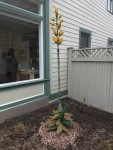
Desert Agave
“Desert Agave” is a type of agave plant found in certain climatic areas of southwest United States and northern Mexico. It lives twenty years or more as a low circular array of sharp leaves and then grows a very tall stem that flowers and releases seeds.The leaves can store liquids for a very long time.The shape of the leaves minimizes their exposure to the sun. The very rare flowering saves energy and moisture. The plant has adapted to the parched air and intense sun of its host climate.
Most plants native to our area have many branches and grow new leaves each year.This maximizes exposure to the sun during the shorter growing season. they have little reason to store moisture and are dormant in winter.These plants have adopted to our climate.
“Desert Agave” exhibited in Beacon, NY in 2016, is based on the actual plant in bloom. It has a low circular array of short pointed leaves on the ground and a single tall stalk that has a colorful display of small flowers near the top. The sculpture is made of steel rod, metal mesh, and colored cement. It measures eight feet high and two feet wide. The steel base will be staked to the ground and will be covered by gravel. The leaves and stalk are colored green, gold, and rust, and the flowers near the top and are yellow-orange. The goal is to attract viewers and engage their thoughts.
The human scale, interesting shapes, color and textures make this sculpture approachable and attractive to people of all ages and interests.Once a person stops to look at this piece, the creative processes might be activated and certain questions may arise: What kind of plant is this? Why does it look so different? Why is it here? Underlying many of these questions is the subject of climate.
The sculpture connects art and climate. Over millions of years plants and animals have slowly adapted to the many unique climates on earth.If humans change the climate too much too fast, plants and animals will not be able to adapt.
Additional Websites: www.beacon3d.org
